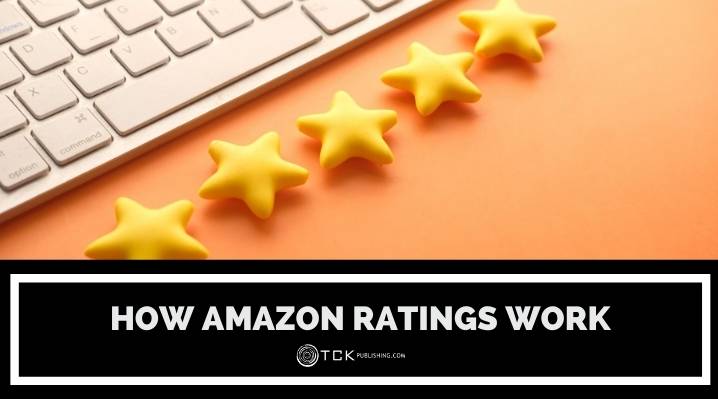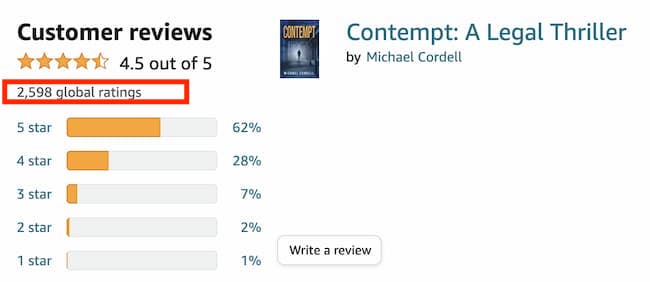
In the past, Amazon shoppers may remember being asked to write a review in order to rate any product on the site.
But over the past year, Amazon has shifted gears and made some changes in an effort to encourage more shoppers to express their opinions.
Customers can now leave simple star-ratings without writing any comments. This change has its pros and cons for both sellers and buyers, which we’ll explain in this post, with a focus on how the update may effect authors.
Amazon Reviews Replaced by Global Ratings
Until late 2019, shoppers on Amazon were required to write an actual review of any length with a title in order to offer their opinion on a product.
Now, customers can leave a simple star rating (on a scale of 1–5 stars), without any further comments.
Since making the change, Amazon now refers to the star-only reviews as “ratings.” So, rather than “2,500 reviews” next to a product, you may now see something like, “2,100 customer reviews and 2,450 customer ratings.” This means that 350 customers opted not to write a review, and only left their star ratings.
Here’s an example from one of our books, Contempt by Michael Cordell. There are almost 2,600 ratings, but just 245 reviews:

While this new system makes it easier and more convenient for shoppers to provide feedback, it means ratings may be given without context or any explanation, which is what has made many reviews so helpful to both shoppers and sellers in the past.
How Star Ratings Are Calculated
One thing that hasn’t changed is that anyone can still leave a rating, regardless of whether or not they actually made a purchase.
However, only ratings from verified purchases will be considered in the product’s overall star rating average, at least until the unverified reviewer adds more details in the form of text, image, or video.
According to Amazon, they calculate a product’s star rating using machine-learned models instead of a simple average. In addition to the verified purchase status, these models consider how recent the rating is, as well as “multiple criteria that establish the authenticity of the feedback.”
What the Change Means to Sellers and Shoppers
Getting genuine reviews is essential to the success of any product, and especially so when it comes to selling books. After all, many of us make our buying decisions after checking out the reviews.
While the new system certainly encourages more readers to leave ratings, it does little in the way of improving relevance or trust.
If you see several one- or two-star ratings for a product without any explanation, you’ll probably wonder what’s wrong with the product.
The truth is that the low rating could be based on any number of factors, from the book’s spine being damaged when its box was tossed against the door, to the wrong edition being delivered. But without any context, other shoppers have no way of knowing that the issues weren’t really relevant to the actual product.
Of course, this system also makes it easier for someone who just doesn’t like the author or simply wants to play pranks to leave poor ratings, because there’s no need to say anything about their rating decision.
On the flip side, the new system could be more balanced if it makes the overall ratings less skewed toward unhappy consumers, who tend to write more reviews.
Still, when sellers do receive poor ratings, there’s really no way to link the rating to a customer in order to reach out and resolve a problem.
What Authors Can Do
We often encourage authors to leave a note to readers at the end of their book that says something like this:
“If you enjoyed my book, I would greatly appreciate it if you left a review so others can receive the same benefits you have. Your review will help me see what is and isn’t working so I can better serve you and all my other readers even more.”
This request for a review—not a rating—shows the reader that you value their feedback, even on things they didn’t quite like.
Sellers and shoppers should negative star-ratings with a grain of salt when they see them, and if as a seller you notice any suspicious activity on your account, contact Amazon’s Seller Support.
Did you find this post helpful? Let us know in the comments below!
If you enjoyed this post, then you might also like:
- Why Did Amazon Remove My Book Reviews?
- The Ultimate Book Marketing Plan: What To Do Before, During, and After Your Launch
- How We Got 1,250+ Amazon Reviews for a Novel in One Year
- How to Get Book Reviews: The System That Got Us 1,000+ Reviews on Amazon
As a blog writer for TCK Publishing, Kaelyn loves crafting fun and helpful content for writers, readers, and creative minds alike. She has a degree in International Affairs with a minor in Italian Studies, but her true passion has always been writing. Working remotely allows her to do even more of the things she loves, like traveling, cooking, and spending time with her family.

How come all the ratings are 4.x?
I hate this change. My novel THE ENTITY started out with 4 reviews, all 5 stars. I now have 36 reviews with a 3.9 rating. I would love to know what the others thought. Over the years I’ve learned more from the bad reviews than the good ones. Not that I don’t like the good ones. I still like being flattered once in a while.
Hi Gary, yes, I know the new change is frustrating for many authors. It would be nice to know the reasons behind bad ratings especially :\
This is s bad move since the actual plus/minus has a reason, and that reason needs to be considered and matched appropriately to make a decision. The idea that more unhappy people write reviews is unhelpful and inconsistent with the data I know: in any system the very happy and very unhappy will write reviews and points will be skewed (by reviewers) even more to edges to match written reviews to resemble an inverted bell curve. Any data otherwise needs sourced and proofed to the goods/services and situation, and any “+1” (more than) evaluation is unhelpful. The key to all reviews is delta from expectations, which have have both incredibly variable intensity and influence. Whether measured or not nearly all the feedback will be expectations and satisfaction driven and based mostly on emotional triggers. The opinion of family members and friends matters to many people, as well. I suggest star ratings without source information is simply a ploy to drive numbers and adds only noise to an already chaotic (causally) system. I’ve also noticed that the more important a review is to an organization (like those that market reviews that are claimed fair as a product itself) skews reviews dramatically, and apparently positively. Finally there are engines that evaluate Amazon and other reviews for authenticity which I use for any purchase worth more than $50.
Very interesting. Takes the mystery out of how anyone can leave a rating without a review…not ideal for reasons offered above in the article. Thanks for the update.
You’re welcome, Clark! We’re glad you found the information helpful, even if it isn’t an ideal update :)